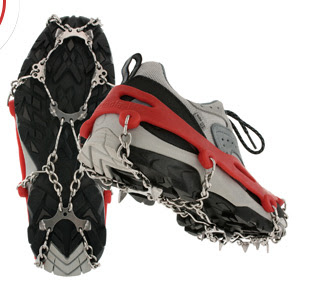Last night I arrived home from a rainy run to find my pair of the just released Kahtoola MICROspikes had arrived. Kahtoola describes the Microspikes as “pocket-sized traction” and that’s about right. The newest addition to the product category that includes Yaktrax and STABILicers, the Microspikes are lightweight devices that you slip on over your shoes to provide traction on ice or snow. Unfortunately, I didn’t have any snow or ice last night… but I DID have the first substantial rain in Arlington in two months! You guessed it, mud testing!
Out of the box, the Microspikes look like a pair of hole-filled rubber circles attached to a set of spikes interlinked by chains. You’ll quickly notice that there are no straps or buckles or or ties – you just slip them on. Although I’ve never used similar systems and did not read any instructions, it was quite easy to figure out how to put on the Microspikes as the front of each one is conveniently enough labeled “front”. With the spikes hanging underneath the rubber, all you do is slip the toe of the shoe you’re wearing into a small slit where the rubber is labeled “front” (raised arrows also point you to the front) and then grab the opposite end, pull back and then up over the heel of your shoe. When you are done securing the front and rear of the Microspikes, be sure that all remaining edges of the rubber portion of the Microspikes are pulled up over the sides of both shoes.
In order for a running traction device to be useful I need to have confidence in it. I need to know that (1) it’s going to provide traction and (2) that it’s not going to spontaneously come of or shift excessively. I’m happy to report that unlike some similar systems I’ve heard about (cough, yaktrax, cough, cough), no matter how aggressive I was in turning or stopping, I didn’t have any problem with the Microspikes coming loose or even shifting. They definitely felt secure – the aspect I was most interested in testing off the bat. As far as traction goes, the 3/8″ spikes gripped hard on anything I could throw at them, but were unobtrusive enough that I didn’t have to alter my stride all. (I’ll have to wait to see if the spikes are long enough to alter my stride on a harder surface like ice.) Although the Kahtoola website puts the weight of Microspikes at 10-15 ounces each depending on size, I’m guessing that’s per pair rather than per shoe as I didn’t notice the weight at all in my short test run.
All in all, I’m very impressed with the Kahtoola MICROspikes out of the box and am looking forward to some icy runs in the Shenandoah this winter.
Don’t want to take my word for it? Read the comments for some in-the-field… or more fittingly on-the-ice experiences. [1/6/09 update: You can now read iRunFar’s Kahtoola MICROspike review as part of iRunFar’s series on winter running traction devices.]
You can pick up the Kahtoola MICROspikes at Amazon.com
You can also pick the Kahtoola MICROspikes Traction System ![]() at Backcountry.com
at Backcountry.com![]() . (On sale for as low as $44.21 – 10/8/08)
. (On sale for as low as $44.21 – 10/8/08)
[Updated 10/25, 9 p.m. – Having now looking at the information the Microspikes came with, I can now confirm that a pair weighs in at 12.5 ounces combined. Perhaps, most impressive is that the rubber stays flexible down to -76 degrees Fahrenheit … may I never test their limits of flexibility.]

